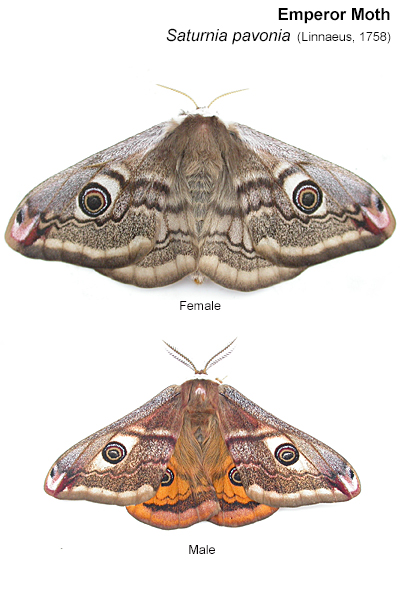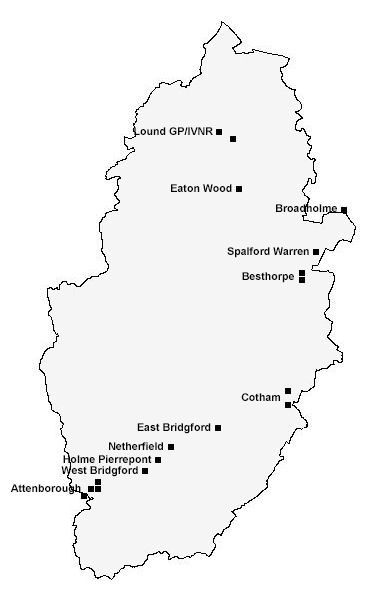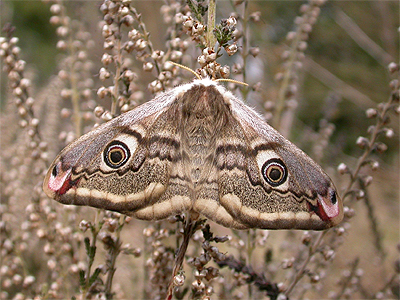

| Recent records of the Emperor Moth in VC56 Nottinghamshire | ||
|
Without any doubt, the Emperor Moth
Saturnia pavonia (Linnaeus, 1758)
is one of the most spectacular moths currently on the UK species list.
The only member of the Saturniidae family found here, it is typically a
moth of upland areas, moorland and heathland,
but it is a moth which has an unexpected history and distribution in Nottinghamshire.
Virtually all of the county's recent records have come from sites lying along the Trent Valley and not from the Sherwood Forest heathlands as many would perhaps would expect. Certainly heathland (lowland heath) would be described as the only typical Emperor habitat we have in Nottinghamshire and it would be logical to assume that its local distribution would be limited to such habitat? Historical Emperors in Nottinghamshire It is J.W. Carr's book "The Invertebrate Fauna of Nottinghamshire" published in 1916, that shows how the Emperor Moth was historically restricted to the sandy heaths of the Sherwood Forest area, but more so the heaths and woodlands in the Mansfield and Newstead areas, rather than those making up the area now known comprising the Sherwood Forest NNR itself. Carr describes the Emperor Moth's Nottinghamshire distribution as being 'formerly common on heaths, now rare'. He goes on to list 'Sherwood Forest (Sterland and Hardy), but this is rather vague and no specific site is mentioned. It was certainly not recorded by the more reliable R.E. Brameld and so Carr may have included Sterland's record this time, purely on the basis that Hardy had also recorded it. There was a record of a larva from Shireoaks in 1899 (Houghton) and the moth was described as 'common on Mansfield Forest and around Blidworth (Henderson)'. Carr continues the account with 'taken very plentifully a few years ago in Newstead Park, but no specimens can now be obtained (Midland Nat., 1884, p.42). Used to be common at both Ratcher Hill and near the Hut on the Newstead Abbey Estate'. |
 |
|
| ... | ||
 |
Modern records and distribution Unfortunately we don't have access to records or information from between the years referred to by Carr (the late 1800's in this instance) and those dating to just after the turn of the present century (from 2003). There are just two historical records from the Bramcote area listed on the NBN Atlas, which are not listed in Carr's book. Despite being a wonderful resource, the continuing lack of Nottinghamshire moth records on the NBN remains a rather worrying trend. At some time during the last century, it seems the Emperor Moth died out from all of its known sites in the Mansfield and Newstead areas. Indeed Carr actually mentions an instance of Emperor Moths dying out at Newstead Park in the latter part of his account. It might be safe to presume then, that the moth declined quite quickly from its former haunts in the Mansfield area, probably sometime in the early 1900's. The cause of decline is unknown, but it seems unlikely to have been 'collected' to the point of extinction, as there is a lack of records from most the well known collectors, or recorders of the time. In fact, it seems surprising that such a spectacular moth was not recorded more often. Surely this would have been one species which any of the entomologists of the day, would have wanted to see? Today, the Emperor Moth's Nottinghamshire distribution is somewhat different. All bar one of the county's most recent records are from sites lying along the Trent Valley. A record from Eaton Wood in 2012, is the only discrepancy in the map showed on the left. Even with eight sites recording Emperor Moths since 2003, the moth appears to be little more than a transient breeder along Nottinghamshire's Trent Valley. It is a difficult moth to pin down (no pun intended), as it has never been recorded consistently from any one site for little more than five or six years. The West Bridgford records seem to be isolated occurences, but the latter record interestingly involved a male being attracted to lure, as did at least one of the Broadholme records. Left:- The distribution of the Emperor Moth in VC56 Nottinghamshire 2003 - 2017. copyright © Trevor and Dilys Pendleton (www.eakringbirds.com) |
|
| ... | ||
|
The county's modern
Emperor Moth records Modern day Emperor Moth records peaked between 2007 and 2010, despite there being no reported records in 2009. Since 2010, it has been reported occasionally, but it is not annually recorded in Nottinghamshire. Before the run of records, it was certainly an extremely scarce moth in the county, in much the same way as it is again now. The use of pheremone lures throughout the Trent Valley would certainly make an interesting project for someone who has the time - in addition to providing some useful distribution data. Attenborough NR - Most of the records for Attenborough NR relate to larvae, with the first dating back to 24/06/07 (van Leeuwen, I.). Further records came the following year, with larvae being recorded on a number of dates, including 05/06/08, 12/06/08, 02/07/08, 13/07/08 and 23/07/08 (all Rogers, R.). Surprisingly, there were no records in 2009, but a single larva was found on 22/06/10 (Thompson, M.). Perhaps emphasising the transient nature of breeding Emperor Moth populations in the county, there has been just one record from the Attenborough area since, when a female was found on the pavement at the Beeston end of the reserve on 25/04/13 (Baker, K.) |
 |
|
| ... | ||
|
Netherfield Lagoons - Recorded on a number of occasions between 2007 and 2011. Initial records were of larvae, with over 30 counted on a number of dates, from three (on site) locations between 08/06/07 and 02/08/07 (Edge, A. and Jenkins, S.). After a blank three years, single females were attracted to MV light on 15/05/10 (Woodward, R. and Howat, C.) Holme Pierrepont - A male attracted to pheremone lure on 24/03/22 (Dulwich, P.) Cotham - There is a single record of over 30 larvae on 13/06/10 (Rogers, R.). No subsequent records. Besthorpe GP - Records of single larva found in 05/08/04 (Johnson, R. and Wood, D. per Wright, S.) and another on 22/06/10 (Heyes, V. and Schofield, L.). The six years between records, means this is the second longest period between reported records from a single site. Besthorpe is well recorded and regularly trapped, so more records would have been expected from the interim period. Spalford Warren - A single female was attracted to MV light on 10/04/15 (Wright, S. and Osborne, J.). No subsequent records, but in view of the records from nearby Broadholme Broadholme - There are three records from this site lying on the Nottinghamshire/Lincolnshire border (but in VC56). Two records involve males recorded on 09/04/10 and 21/04/11, with a female recorded on 09/05/21 (Gray, M.). Eaton Wood - An adult attracted to MV light on 26/03/12 (Watkin, C. and Hall, R.) with a second record ten years later on 22/03/22 (Watkin, C.) Lound GP/Idle Valley NR - A female found at Tiln Pits North 04/05/20 (Nelson, S. per Vickers, M.) and most recently, a male in Lound village 27/03/22 (Freeman, P.) East Bridgford - Three males to garden pheremone lure 27/03/22 (Reece, J. and Reece, I.) |
||
|
Sources and record
contributors The records for the Nottinghamshire distribution map are currently provided by the following contributors and sources. Martin Gray Netherfield Wildlife Group Nottinghamshire Wildlife Trust Richard Rogers Sheila Wright (Nottinghamshire macro moth report 2004) Sheila Wright (Nottinghamshire macro moth report 2007) Sheila Wright (Nottinghamshire macro moth report 2010) Sheila Wright (Nottinghamshire macro moth report 2012) Sheila Wright (Nottinghamshire macro moth report 2013) Sheila Wright (Nottinghamshire macro moth report 2015) Sheila Wright (Nottinghamshire macro moth report 2017) |
| Moths |
| Homepage |